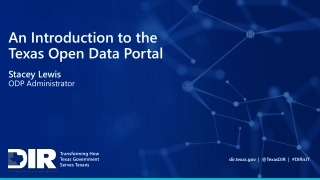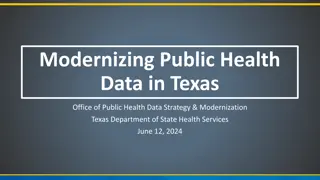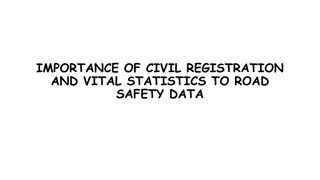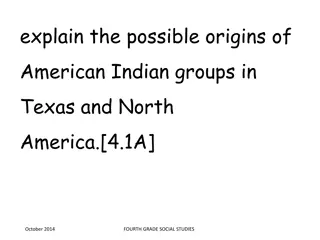Understanding Vital Events Data Management in Texas
Explore the process of managing vital event data in Texas, including birth and death records. Learn how data is collected, entered into databases, and utilized for public health surveillance, mortality statistics, natality statistics, and research purposes. Discover the role of the Vital Events Data Management Team in ensuring data accuracy and consistency. Gain insights into the importance of vital statistics in monitoring health trends and improving community well-being.
Download Presentation

Please find below an Image/Link to download the presentation.
The content on the website is provided AS IS for your information and personal use only. It may not be sold, licensed, or shared on other websites without obtaining consent from the author. Download presentation by click this link. If you encounter any issues during the download, it is possible that the publisher has removed the file from their server.
E N D
Presentation Transcript
Texas Vital Events Data Mortality and Natality data in Texas Victor A. Farinelli
What is Vital Statistics/Event Data? Pregnancy history Characteristics of labor and delivery Birth Newborn information Geospatial data Cause of death data Death Injury information Geospatial data Cause of fetal death Fetal Death Pregnancy history Characteristics of labor and delivery Newborn information Geospatial data
Birth Data Birth data entered in the Texas Electronic Vital Events Registration System (TxEVER) database by Doctor, Midwife or Hospital Designee Birth certificate is printed and archived
Death and Fetal Death Data Funeral director notified when medical certification is completed Death and Fetal Death data entered in to TxEVER by Funeral Director Funeral home releases the data to the Vital Statistics Section Electronically assigned to Medical Certifier (Doctor, Medical Examiner, Justice of the Peace) Medical Certifier enters cause and manner of death and electronically signs it Vital Statistics prints a hardcopy death or fetal death record and archives the record
Vital Events Data Management Team s Role Vital Event Data is extracted from TxEVER Database Datasets are created for each event type The data is reviewed for inconsistency and updated as needed A final statistically locked dataset is created and frozen from any further edits
What is the Data Used for? Public Health Surveillance. Mortality Statistics. Natality Statistics. Research. University studies approved by the Committee on Requests for Personal Data (Institutional Review Board) Data sent to local health entities to be used to improve public health in their communities. Death Rates Birth Rates Leading causes of death Birth Defect Surveillance Maternal and Infant mortality Maternal Child Health
Use of Population Data Birth rates are calculated based on mother s resident address at the time of birth. Overall crude birth rate: total number of live births for a specific area during a specified time, per 1,000 population Crude birth rate by demographics: the number of live births per demographic group (mothers age, race/ethnicity, etc.) for a specific area during a specific time, per 1,000 females General fertility rate is the number of live births to mothers aged 15 to 44 per 1,000 females of child-bearing years (ages 15-44)
Use of Population Data Death rates are calculated based on decedent s resident address at the time of death. the time of death Death rates calculated based on decedent s resident address at area during a specified time, per 100,000 population Overall crude death rate: total number of deaths for a specific population of that age group 100,000 Age-adjusted death rate: deaths in age group estimated
Crude Birth Rate by Race and Ethnicity 2016 to 2020* 40.0 34.9 35.0 32.8 29.9 29.8 Per 1,000 Females 30.0 27.7 27.9 25.2 25.0 24.2 22.1 20.0 19.3 15.0 2016 Non-Hispanic White 2017 Non-Hispanic Black 2018 Hispanic 2019 2020 Non-Hispanic Asian Non-Hispanic Other *Birth data for 2020 are Provisional.
Fertility Rate by Race and Ethnicity from 2016 to 2020* 80.0 76.6 75.0 Per 1,000 Women Aged 15 to 44 68.9 70.0 69.3 66.9 65.0 68.2 63.2 62.8 60.6 59.7 60.0 57.1 55.0 53.1 52.0 50.0 2016 2017 2018 2019 2020 Non-Hispanic White Non-Hispanic Asian Non-Hispanic Black Non-Hispanic Other Hispanic Total Births *Birth data for 2020 are Provisional.
Crude Death Rate Race and Ethnicity from 2016 to 2020* 1,300.0 1,199.5 1,100.0 1,036.3 888.1 900.0 Per 100,000 Population 839.9 718.2 700.0 553.4 689.9 500.0 371.6 330.4 300.0 327.1 260.3 258.2 100.0 2016 2017 2018 2019 2020 All Texas Deaths Non-Hispanic White Non-Hispanic Black Hispanic Non-Hispanic Asian Non-Hispanic Other *Death data for 2020 are provisional.
Crude Death Rate by Cause of Death for 2020* Diseases of heart 180.0 168.7 Malignant neoplasms 160.0 Crude Death Rate per 100,000 Population 141.6 COVID-19 140.0 Accidents 120.0 103.4 Alzheimers disease 100.0 Cerebrovascular diseases 80.0 Chronic lower respiratory disease 60.0 42.9 40.1 Diabetes mellitus 39.2 35.0 40.0 26.8 Chronic liver disease and cirrhosis 16.6 14.8 20.0 Nephritis, nephrotic syndrome and nephrosis 0.0 *Death data for 2020 are provisional.
Life Expectancy at Birth 2020* Non-Hispanic Other 80.3 Non-Hispanic Asian 81.5 Hispanic 76.7 Non-Hispanic Black 73.0 Non-Hispanic White 76.8 All Persons 77.0 68.0 70.0 72.0 74.0 76.0 78.0 80.0 82.0 84.0 All Persons Non-Hispanic White Non-Hispanic Black Hispanic Non-Hispanic Asian Non-Hispanic Other *Birth and death data for 2020 are provisional.
Requesting Data The Texas Health Data query system provides customized statistical reports using 2005-2019 birth data and 2006-2019 death data. healthdata.dshs.texas.gov Provisional (subject to change) data for 2020-2021 are available upon request.
Requesting Data To request data, email vstat@dshs.texas.gov Please be prepared to provide the following information when making an aggregate data request: Description of data needed (e.g., totals, rates, percentages, etc.) Years needed Geographic area needed (e.g., Texas statewide or a specific county) Whether you need residential data (based on place of residence) or occurrence data (based on where the event happened) Whether you need data broken down by other criteria (e.g., sex, age group, race/ethnicity, county, or N/A)
Thank you! Texas Vital Events Data vstat@dshs.texas.gov























